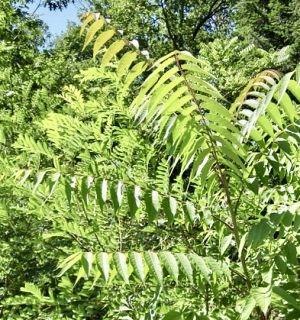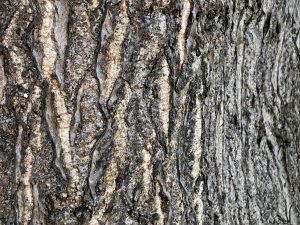The tree of heaven (2).

The woodlands blog has previously reported on the danger that the Tree of Heaven presents. Whilst its foliage and fruits are attractive, it can be a highly invasive plant. it can overwhelm natural vegetation / species because
- It grows extremely rapidly
- It can produces thousands and thousands of seeds in any given year
- It can spread by underground suckers
- It produces chemicals that inhibit the germination and growth of other species - a phenomenon known as allelopathy.
The tree of heaven (Ailanthus altissima) was first introduced to the UK in the mid eighteenth century, and specimens were planted in parks and civic settings. As it is dioecious, it needs male and female plants in proximity for good seed set and warm weather. However, botanists now believe that our warmer summers and milder winters could lead to the tree becoming a serious ‘pest’.
This is certainly the case in the United States, where it has spread to all but six of the States. The tree colonises disturbed areas (for example, where there has been fire damage); it is also found alongside roads. Ailanthus is a significant problem throughout US forests, displacing native trees, such as red oak. The trees are also responsible for damage to infra-structure such as sewers, pavements, and the foundations of buildings. Removing the trees is very, very difficult.
Not only has the tree has no natural ‘predators’ seemingly; but it is home to a number of destructive insect pests (in the US), such as
- The spotted lantern fly - a colourful plant hopper that can attack a number of species including fruit trees and grape vines. It too hails from China - so the two have been reunited across the pacific ocean.
- The brown marmorated stink bug and
- The Asiatic shot-hole borer. These have damaged U.S. forests, especially those rich in maple species, and a number of commercial crops, such as apples and peaches.

However, all might not be lost. There might be a way to bring the ‘tree of heaven’ under control. It is possible that one of the wilt fungi may be used - a form of biocontrol. The fungus in question is Verticillium nonalfalfae and it kills the tree. This fungus kills by ‘invading’ the trees’ vascular system (specifically the xylem) so that it can no longer transport water and mineral salts to the aerial regions - so the tree literally ‘wilts’. As the tree dies, fungal spores fall into the soil, where they have opportunities for further infection / colonisation of hosts.
Experiments are now underway - using different sites in Virginia and Pennsylvania dominated by Ailanthus to check that the fungus (V. nonalfalfae) kills the Ailanthus but does not harm any other plants. So far the results look promising as a form of biocontrol.
Comments are closed for this post.
Discussion
A question
I purchased the so called tree of heaven from a garden centre about 5 years ago not aware of the damage it can cause I’m
trying to dig it out but will the roots still grow ?

There appears to be some useful advice on this site
https://www.gardeningknowhow.com/plant-problems/weeds/tree-of-heaven-weed-control.htm
blogs
11 July, 2021